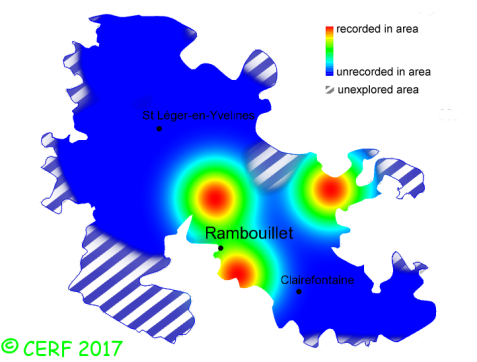|
Crepidotus cesatii (Rabenh.) Sacc.
|
common name(s) : Roundspored Oysterling
New classification: Basidiomycota/Agaricomycotina/Agaricomycetes/Agaricomycetidae/Agaricales/Inocybaceae
Former classification: Basidiomycota/Homobasidiomycetes/Agaricomycetideae/Cortinariales/Crepidotaceae
synonyms: Crepidotus cesatii-cesatii, Crepidotus sphaerosporus, Claudopus variabilis-sphaerosporus
edibility : inedible
|
|
|
The cap is white, becoming dull ochre with age, convex, kidney- or bracket-shaped if attached laterally, sometimes circular if attached from the top to its substrate, often tiered; its margin is incurved and thin, grooved and wavy.
The cap surface is downy to felty, slightly wrinkled radially, non gelatinous.
The stem is absent most of the time, sometimes present but rudimentary.
The flesh is whitish, unchanging; its taste is mild, tasteless; the odour is faint or not distinctive;
its texture is fibrous.
The gills are white then salmon-ochre to yellowish, with a hairy and white edge, distant .
The spore print is snuff-brown. This species is saprophytic.
It grows on dead wood, on stumps, large fallen branches of deciduous trees.
The fruiting period takes place all year long.
| Dimensions: | width of cap approximately 1 cm (between 0.2 and 2 cm) |
| | height of stem approximately 0.1 cm (between 0 and 0.1 cm) |
| | thickness of stem (at largest section) approximately 0.1 mm (between 0 and 0.1 mm) |
Distinctive features : milk cap, silky-felty, convex, kidney-shaped if attached laterally, sometimes circular if attached from the top to its substrate, often tiered; stem absent or rudimentary; white gills, becoming white then salmon-ochre to yellowish, fairly distant; on fallen deciduous wood branches in wet copses; all year long
Crepidotus cesatii is quite rare and localised in the forest of Rambouillet, and is frequent, more generally speaking
.
|  | | Above : distribution map of Crepidotus cesatii in the forest of Rambouillet |
|
page updated on 14/01/18